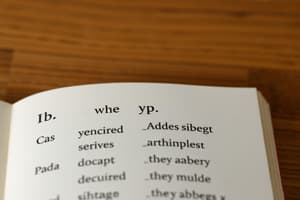Podcast
Questions and Answers
Which sentence correctly uses the past tense form of "to be" with a plural noun?
Which sentence correctly uses the past tense form of "to be" with a plural noun?
Which sentence uses the verb "to be" to express a state or condition?
Which sentence uses the verb "to be" to express a state or condition?
Which sentence uses the verb "to be" to form the passive voice?
Which sentence uses the verb "to be" to form the passive voice?
Which sentence correctly uses the present participle form of "to be"?
Which sentence correctly uses the present participle form of "to be"?
Signup and view all the answers
Which sentence uses the correct form of "to be" in the future simple tense?
Which sentence uses the correct form of "to be" in the future simple tense?
Signup and view all the answers
Which sentence uses the verb "to be" to link words or phrases?
Which sentence uses the verb "to be" to link words or phrases?
Signup and view all the answers
Which of the following sentences is in the past perfect tense?
Which of the following sentences is in the past perfect tense?
Signup and view all the answers
Which of the following sentences uses the "there" + be structure?
Which of the following sentences uses the "there" + be structure?
Signup and view all the answers
Flashcards
Auxiliary Verb
Auxiliary Verb
A verb used to help another verb express tense, mood, or voice.
Forms of 'to be'
Forms of 'to be'
Different versions of the verb 'to be' based on tense and subject.
Present Tense 'to be'
Present Tense 'to be'
'Am', 'is', and 'are' used to express current states or conditions.
Past Tense 'to be'
Past Tense 'to be'
Signup and view all the flashcards
Present Participle
Present Participle
Signup and view all the flashcards
Passive Voice
Passive Voice
Signup and view all the flashcards
Subject-Verb Agreement
Subject-Verb Agreement
Signup and view all the flashcards
Future Tense using 'to be'
Future Tense using 'to be'
Signup and view all the flashcards
Study Notes
Overview of the Verb "to be"
- The verb "to be" is a crucial auxiliary verb in English grammar.
- It expresses existence, state of being, or a condition.
Forms of "to be"
-
Present tense:
-
am (used with I)
-
is (used with he, she, it, and singular nouns/pronouns)
-
are (used with you, we, they, and plural nouns/pronouns)
-
Past tense:
-
was (used with I, he, she, it, singular nouns/pronouns)
-
were (used with you, we, they, and plural nouns/pronouns)
-
Past Participle:
-
been (Used in the perfect tenses, e.g., "I have been")
-
Present Participle:
-
being (used as a gerund, in progressive tenses, or in the passive voice)
-
Future tense using "to be" + going to:
-
"I am going to" + perform an action
Uses of "to be"
- Expressing existence:
- "She is a doctor".
- "The cat is on the mat".
- Expressing a state or condition:
- "He is happy".
- "My computer is broken".
- Linking words or phrases:
- "This is my dog".
- "He was late because of the traffic".
- Forming the passive voice:
- "The cake is eaten by Jack".
- Expressing ongoing action (be + ing):
- "I am reading a book".
- Expressing possession
- "This is my car" (showing possession of the noun "car")
- Special uses:
- "There is a cat."
- "There are many cats." (using "there" + be)
- "I will be going to the store". (In the future tense with the "will")
Tenses involving "to be"
-
Present Simple:
-
Expresses habitual action or permanent states.
-
"The dog is hungry."
-
Present Continuous:
-
Expresses actions happening now.
-
"She is eating lunch."
-
Past Simple:
-
Expresses action completed in the past.
-
"They were at the park yesterday".
-
Past Continuous:
-
Expresses actions in progress in the past.
-
"The children were playing games".
-
Present Perfect:
-
Expresses actions beginning in the past and continuing to the present.
-
"I have been to the museum today."
-
Past Perfect:
-
Expresses actions completed before another action in the past.
-
"She had been studying when I arrived."
-
Future Simple:
-
Expresses actions that will happen in the future.
-
"She will be at work tomorrow."
-
Future Continuous:
-
Expresses actions that will be in progress in the future.
-
"The children will be playing in the park later".
Subject-Verb Agreement with "to be"
- The verb "to be" changes its form to agree with the subject.
- "I am", "You are", "He/She/It is", "We are", "They are"
- "I was", "You were", "He/She/It was", "We were", "They were"
Contractions of "to be"
- Common contractions:
- I'm (I am)
- you're (you are)
- he's (he is/he has)
- she's (she is/she has)
- it's (it is/it has)
- we're (we are)
- they're (they are)
- wasn't (was not)
- weren't (were not)
Irregularities
- Note the irregular forms of "to be," particularly in the past tense (was/were).
Importance of "to be"
- The verb "to be" is fundamental to expressing basic information about people and things.
- Its usage is essential for clear communication.
Studying That Suits You
Use AI to generate personalized quizzes and flashcards to suit your learning preferences.
Description
This quiz covers the verb 'to be', focusing on its various forms and uses in English grammar. Explore its present and past tenses, as well as its role in expressing existence, state, and linking phrases. Perfect for learners looking to strengthen their grasp of fundamental English structures.




